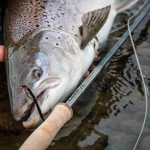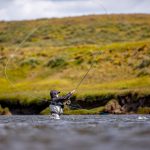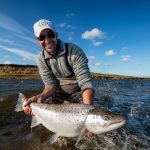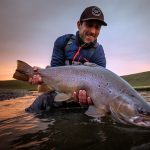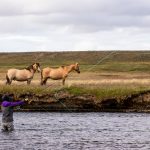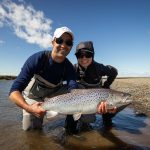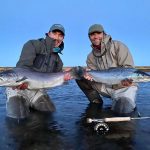What time of the year should I come?
Kau Tapen lodge is situated in the middle section of The Río Grande. It has the privilege to be situated just upstream from the confluence of The Río Grande with The Río Menendez. Menendez flows from the south, fed by the cold water of the Andes range with snowmelt, and collects rainfall from a glacial basin. It is the largest tributary of the system bringing up to 30% of the water mass The Río Grande has in its lower stretch. When you spend the week fishing in Kau Tapen lodge, you will fish The Río Grande and Río Menendez as both are included in the lodge’s fishing beat rotations.
January (opening)
Kau Tapen lodge starts its fishing season at the beginning of January. At that moment you will be able to catch medium-sized fresh fish and a good amount of colored-up trophy fish, mainly females, that got into the river in an early run. These big fish enter the river in November and distribute all along the midsection of the river, where Kau Tapen lodge is situated. This run is abundant in numbers and its distribution is uniform in most of the pools. That “older” run plus the fresh running fish set up a great scenario to kick off the season!
In early January the river level is on the higher side, with a nice even speed along the pools but very safe to wade and fish. You will have to cover a lot of water with your flies and learn to feel the subtle takes of early-season sea trout. Throughout January, the river starts to drop its level – in a normal season and with no extraordinary and exceptional rains – and reaches its lowest point during the first two weeks of February.
February (mid-season)
During February the pools start to flow slower, the water becomes clearer and warmer during the warmest month of the year in Tierra del Fuego. All this leads us to wade and cast carefully, use lighter rods and lines, and longer, thinner leaders. We also start using smaller flies from the first cast of the day as the fish get more skittish and starting with a heavy line with a big profile fly can be counterproductive most of the time.
By the end of February, our seasonal rains start to arrive. That new water generates a bigger movement of fish, which start arriving from the lower sections of the river. It also prompts the trout that were settled along Kau Tapen’s stretch to start shifting positions and move from pool to pool trying to find better places to sit as they get stirred up by the arrival of new fish. With these rains, the river increases flow and that is something that keeps happening until the end of the season in early April.
At Kau Tapen, you will experience three big runs of fresh fish: November, the end of January, and in mid-March. By the end of the season, they get mixed with the fish that were already in the stretch. Due to this situation it is very important to fish the heads and tails of the pools in every beat.
The dark-colored big males can be caught with different techniques and flies according to the watercolor and temperature from mid-February to the end of the season. During this part of the season, their level of aggression increases as they start fighting over the fresh, egg-laden, trophy-sized females that are arriving from the lower part of the river.
During the whole season, there is continuous arrival of small to medium-sized chrome fresh fish (3 to 10 pounds). They run in very important numbers, especially after each full moon / high tide cycle.
Late March – April (End of season)
April is the month of the big catches with a higher-than-average size. There is almost no activity with regards to the smaller fish. The water is cold due to snowmelt in the Andes and freezing nights. These seasonal changes mean that early in the morning and late afternoon the fish activity is very scarce. But, around noon and in the early afternoon hours, the activity improves as the water rises in temperature.
April can be a difficult month, as the weather can be tricky. One year can be great and the river be in perfect shape and the next year it can be overflowing with murky water. The prize? If you hook a fish, it’s nearly a certainty that it will be a trophy that will stay in your memory for a long time!
As far as fishing techniques go, we recommend spey/ two-hand rods no longer than 13 feet. The use of switch and single-handed rods is possible during the whole season, always depending on the wind and the angler’s skills. Any of those rods can be fished with lines ranging from Floating to Type 6, using multi-tip lines. Having a good array of tips from 3 to 15ft is the best option to cover almost every situation.
The Río Menendez
The Menendez is an amazing river! It is not an alternative river anymore and it has gained international respect that competes in reputation with The Río Grande itself.
The new roads along the river give our guides better accessibility to most of the pools for every client and allow the river to become a permanent fixture in the lodge’s beat fishing rotation. And most of all, it is a pleasure to fish! 70% of the time you will fish it with single-hand rods and light switch rods matched with an intermediate line or tip. We can also say that the fish fight differently when we compare them with The Grande’s specimens due to Menendez’s shallow depth and structure so the fish are able to run fast between deep pockets and underwater structures.
The river experiences less seasonal water level fluctuations than the Grande and they work in a different but complementary way. It is a great option when one of the rivers gets un-fishable due to water level and color shifts after heavy rain or substantial snowmelt. When The Río Grande has a sudden water level increase we can see a massive push of large fish into The Menendez even if it is running with a low level making the fishing an absolute blast.
When we open the season in late December/early January The Menendez runs with a normal to low water level. Around mid-to-late February, its level gets a nice lift due to rains and it keeps that higher level all the way to the end of the season. This is when most of the tributary’s record fish are caught. At this time the river’s flow, depth, conditions, and structure make The Menendez an absolute favorite for the fish, and its pools become overcrowded with trout. The proof of that is the 3 last seasons Kau Tapen’s records were caught in The Menendez and in the second half of the season.
According to the biological studies that we facilitate in the Rio Grande Basin, the radio tagging results showed that this section of The Menendez River and the lowest section of the Grande (Villa Maria lodge stretch) are the principal spawning grounds for the sea trout of the system and where the record-sized males and females are located.
The wind is not a problem when you have to fishThe Menendez River as the casting distances are short. Ideally, we have to treat it as a spring creek and the best result is when you fish it without stepping into the river and, even better, if you are able to cast from a few steps back from the shore.
The sun can be a problem, especially in the evening as it drops straight in the face of the fish. During morning sessions it’s not such a big problem. Cloudy days and twilight are the best times to approach and fish it. It maintains excellent water clarity through the season and it is not a deep river, so, we have to be extremely careful about casting our shadows into the pools. The river’s morphology and smooth flow make The Menendez a fantastic river to catch sea-run brown trout using less common techniques like dry flies and skated flies. Bombers, Riffle Hitch tube flies, and Green Machines are all great options when the river conditions and the wind suits these techniques.
Kau Tapen Lodge’s beats offer unbeatable access to the fishing sections of the Rio Grande’s midsection fishery. Here The Menendez and Grande work together according to the seasonal pulses of rainwater, and multiple runs of fish throughout the season. The result is an excellent balance in the angler’s fishing week with opportunities for solid catch numbers, trophy-sized fish, and a great variety of fishing spots and angling challenges.








